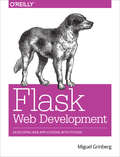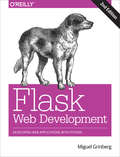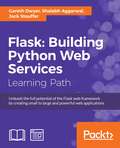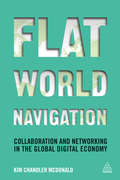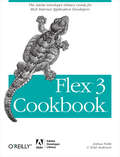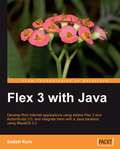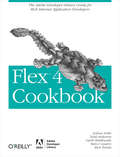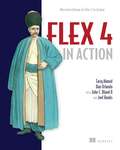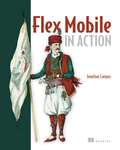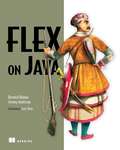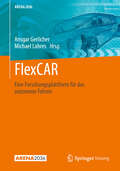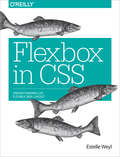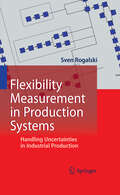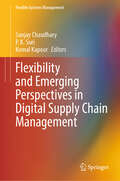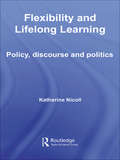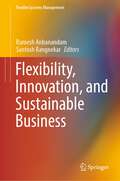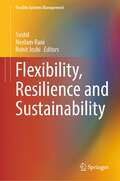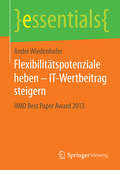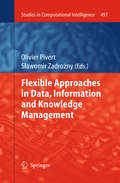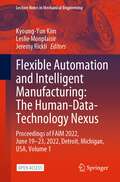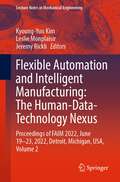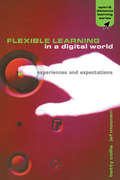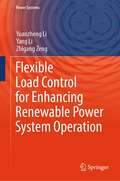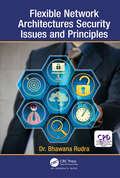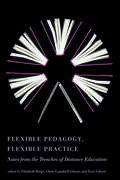- Table View
- List View
Flask Web Development
by Miguel GrinbergTake full creative control of your web applications with Flask, the Python-based microframework. With this hands-on book, you'll learn Flask from the ground up by developing a complete social blogging application step-by-step. Author Miguel Grinberg walks you through the framework's core functionality, and shows you how to extend applications with advanced web techniques such as database migration and web service communication.Rather than impose development guidelines as other frameworks do, Flask leaves the business of extensions up to you. If you have Python experience, this book shows you how to take advantage of that creative freedom.Learn Flask's basic application structure and write an example appWork with must-have components--templates, databases, web forms, and email supportUse packages and modules to structure a large application that scalesImplement user authentication, roles, and profilesBuild a blogging feature by reusing templates, paginating item lists, and working with rich textUse a Flask-based RESTful API to expose app functionality to smartphones, tablets, and other third-party clientsLearn how to run unit tests and enhance application performanceExplore options for deploying your web app to a production server
Flask Web Development: Developing Web Applications with Python
by Miguel GrinbergTake full creative control of your web applications with Flask, the Python-based microframework. With the second edition of this hands-on book, youâ??ll learn Flask from the ground up by developing a complete, real-world application created by author Miguel Grinberg. This refreshed edition accounts for important technology changes that have occurred in the past three years.Explore the frameworkâ??s core functionality, and learn how to extend applications with advanced web techniques such as database migrations and an application programming interface. The first part of each chapter provides you with reference and background for the topic in question, while the second part guides you through a hands-on implementation.If you have Python experience, youâ??re ready to take advantage of the creative freedom Flask provides. Three sections include:A thorough introduction to Flask: explore web application development basics with Flask and an application structure appropriate for medium and large applicationsBuilding Flasky: learn how to build an open source blogging application step-by-step by reusing templates, paginating item lists, and working with rich textGoing the last mile: dive into unit testing strategies, performance analysis techniques, and deployment options for your Flask application
Flask: Building Python Web Services
by Shalabh Aggarwal Jack Stouffer Gareth Dwyer<P><P>Unleash the full potential of the Flask web framework by creating small to large and powerful web applications <P><P>About This Book <P><P>Create your own world-class applications and master the art of Flask by unravelling its enigma through this journey <P><P>Packed with recipes containing lots of sample applications to help you understand the intricacies of Flask web programming <P><P>Work with scalable Flask application structures to create complex web apps <P><P>Who This Book Is For <P><P>This learning path is ideal developers who know the basics of Python and want to learn how to use the Flask framework to build powerful web solutions in Python. <P><P>What You Will Learn <P><P>Build three web applications from the ground up using the powerful Python micro framework, Flask. <P><P>Extend your applications to build advanced functionality, such as a user account control system using Flask-Login <P><P>Learn about web application security and defend against common attacks, such as SQL injection and XSS <P><P>Integrate with technologies like Redis, Sentry, MongoDB and so on <P><P>Build applications with integrations to most of the login mechanisms available <P><P>Don't just stop at development. Learn about deployment and post-deployment <P><P>Use SQLAlchemy to programmatically query a database <P><P>Develop a custom Flask extension <P><P>In Detail <P><P>Are you a fan of Python? Want to use it to create powerful web applications? Then Flask is the perfect choice for you. This course will take you through the intricacies of the Flask Microframework, covering all it's components and elements and how to integrate it with useful third party libraries. Dive deep into what Flask has to offer and then you will create multiple Python apps from scratch on your own. <P><P>The first module will introduce you to web development using Flask to building fully functional web applications. Hands-on and pragmatic, this tutorial goes right to the crux of Flask by showing you how to build challenging real-world applications. <P><P>The second module introduces you to a number of recipes that will help you understand the power of Flask and its extensions. Start by seeing the different configurations that a Flask application can make use of. By the end of this module, you will have gained all the knowledge required to write Flask applications in the best possible way, and scale them with best practices. <P><P>The final module will walk you through advanced Flask topics while providing practical examples of for all your lessons learned. The module closes with a discussion of the different platforms that are available to deploy a Flask app on, the pros and cons of each one, and how to deploy on each one. <P><P>This Learning Path combines some of the best that Packt has to offer in one complete, curated package. It includes content from the following Packt products: <P><P>Flask By-Example: Gareth Dwyer <P><P>Flask Framework Cookbook: Shalabh Aggarwal <P><P>Mastering Flask: Jack Stouffer <P><P>Style and approach <P><P>Filled with practical examples and recipes, this course is a great combination of example-driven learning complemented by exciting techniques to build powerful Python web applications with the Flask framework
Flat World Navigation
by Kim Chandler McdonaldFlat World Navigation introduces the new future of work in the 'flattened world' of the new digital attention-based economy, where real connections can be made in seconds across departments, businesses, cultures and countries. Combining the best elements of networking, social media outreach and collaborative techniques, flat world navigation is an essential capability to build and maintain relationships between colleagues, customers and partners. Employees who can transform themselves into flat world navigators, experts in mediating these powerful relationships and bringing the customer into the conversation, will mean the difference between success and failure in business. Flat World Navigation includes exclusive insights and interviews with international business leaders who successfully use flat world navigation skills, such as the Emmy-winning former NBC and Wall Street Journal reporter Kare Anderson, Sandy Carter at IBM, Gordon Feller at CISCO Systems, Aria Finger at DoSomething.org, Louise Guido at ChangeCorp, Jeffrey A. Finkle at the International Economic Development Council and Carolyn Lawrence, CEO of Women of Influence. This book is grounded in real-world experience with insights and advice to build your skills base and empower the next generation of business people. Additionally, it is of great use to business owners and managers looking to effectively leverage the skills of these flat world navigators, whose critical role brings attention to ideas, products and services and, as such, must be part of a successful business strategy.
Flex 3 Cookbook: Code-Recipes, Tips, and Tricks for RIA Developers (Adobe Developer Library)
by Joshua Noble Todd AndersonThe best way to showcase a powerful new technology is to demonstrate its real-world results, and that's exactly what this new Cookbook does with Adobe Flex 3. Wide ranging and highly practical, Flex 3 Cookbook contains more than 300 proven recipes for developing interactive Rich Internet Applications and Web 2.0 sites. You'll find everything from Flex basics, to solutions for working with visual components and data access, to tips on application development, unit testing, and using Adobe AIR. You also get ideas from the development community. Through its Flex Cookbook website (www.adobe.com/devnet/), Adobe invited Flex developers to post their own solutions for working with this technology, and from hundreds of posts, the authors chose the best and most useful solutions to supplement Flex 3 Cookbook. Each recipe inside provides a solution to a common problem, explains how and why it works, and offers sample code that you can put to use immediately. Topics include:Containers and dialogues Working with Text Data driven components DataGrid and Advanced DataGrid ItemRenderers and Editors Images, bitmaps, videos, and sounds CSS, styling, and skinning States and effects Working with Collections, arrays, and DataProviders Using DataBinding Validation, formatting, and regular expressions Using Charts and data visualization Services and Data Access Using RSLs and Modules Working with Adobe AIR Whether you're a committed Flex developer or still evaluating the technology, you'll discover how to get quick results with Flex 3 using the recipes in this Cookbook. It's an ideal way to jumpstart your next web application.
Flex 3 with Java
by Satish KoreThe author's experience in creating applications using Flex enables him to share insights on using it effectively in a clear, simple, and concise manner. His approach will help you gain hands-on programming experience in Flex 3 and ActionScript 3.0. The book focuses on important features of Flex 3 and ActionScript 3.0 and gives clear instructions and precise code examples to explain features and ensure that you actually learn as you read. This book is a good starting point for any developer with a little experience in Java programming to get going with Adobe Flex 3 and ActionScript 3.0 development. You may be a software developer/professional who wishes to learn and understand Flex 3 technology for developing Rich Internet Applications. If you are a system analyst who wants to explore and understand Flex 3 then this is an ideal book for you.
Flex 4 Cookbook: Real-world recipes for developing Rich Internet Applications
by Joshua Noble Todd Anderson Rich Tretola Marco Casario Garth BraithwaiteWith this collection of proven recipes, you have the ideal problem-solving guide for developing interactive Rich Internet Applications on the Adobe Flash Platform. You'll find answers to hundreds of common problems you may encounter when using Adobe Flex, Flex 4 Framework, or Flash Builder, Adobe's GUI-based development tool. Flex 4 Cookbook has hands-on recipes for everything from Flex basics to solutions for working with visual components and data access, as well as tips on application development, unit testing, and Adobe AIR. Each recipe provides an explanation of how and why it works, and includes sample code that you can use immediately. You'll get results fast, whether you're a committed Flex developer or still evaluating the technology. It's a great way to jumpstart your next web application. Topics include: Using Spark Component Text Layout Framework Groups and Layout Spark List and ItemRenderer Images, bitmaps, videos, and sounds CSS, styling, and skinning States and Effects Working with Collections Using DataBinding Validation, formatting, and regular expressions Using Charts Services and Data Access Using RSLs and Modules Working with Adobe AIR 2.0
Flex 4 in Action: Revised Edition Of Flex 3 In Action
by Joel Hooks Dan Orlando Tariq AhmedFlex 4 in Action is an easy-to-follow, hands-on Flex 4 tutorial. Revised and updated from the previous edition on Flex 3, this book is chock-full of examples, goes beyond feature coverage, and helps readers put Flex to work in real day-to-day tasks. This book helps Flex developers make their Flex applications stand out from the crowd. How comprehensive is Flex 4 in Action?Interesting themes, styles, and skins? It's in there.Working with databases? You got it.Interactive forms and validation? You bet.Charting techniques to help you visualize data? Bam!Many Flex books are overwhelming to new users-focusing on the complexities of the language and super-specialized subjects in the Flex ecosystem. Flex 4 in Action filters out the noise and dives into the core topics users need every day. Using numerous easy-to-understand examples, Flex 4 in Action provides a strong foundation that readers can build on as the complexity of their projects increases. Purchase of the print book comes with an offer of a free PDF, ePub, and Kindle eBook from Manning. Also available is all code from the book.
Flex Mobile in Action
by Jonathan CamposWith constant innovation on the iOS, Android, and BlackBerry platforms, the mobile device landscape is complicated and changing rapidly. Adobe leads the way with Flex Mobile, a new technology that provides a single development environment that exports applications to any mobile platform, eliminating the need to write and re-write code.Flex Mobile in Action teaches how to use the powerful Flex Platform to create compelling mobile applications that can stretch across Apple iOS, Android, and BlackBerry devices. It contains practical application development techniques such as accessing native device capabilities, choosing the right architectural patterns, and building data access models. It also covers the new Flex 4.6 with Flash Builder which builds on Flex 4.5 for the creation of outstanding mobile applications.
Flex on Java
by Jeremy Anderson Bernerd AllmonUnlike many Flex books that presume readers want to develop applications from scratch, Flex on Java is for developers in the real world-where Flex is one more technology being added to existing systems developed in Java, and where integration is the key indicator of success.Written for Java developers beginning to use Flex, Flex on Java shows how to use Flex alongside existing Java applications, and how to integrate Flex using familiar server-side technologies such as Spring, EJBs, JMS, and more. The authors, both Agile development experts, focus on Agile and test-driven development to enable readers to redesign applications that deliver more value and with zero defects. Throughout the book, readers will apply these techniques to refactoring a single application into a rich internet application using Flex and the BlazeDS framework. Purchase of the print book comes with an offer of a free PDF, ePub, and Kindle eBook from Manning. Also available is all code from the book.
FlexCAR: Eine Forschungsplattform für das autonome Fahren (ARENA2036)
by Ansgar Gerlicher Michael LahresDas Buch "FlexCAR: Die Forschungsplattform von morgen" beschreibt ein innovatives Forschungsprojekt, das sich mit flexiblen Produkt- und Produktionskonzepten für modulare Fahrzeuge beschäftigt. Nach einer Einführung und Motivation des Projekts wird das Vorgehensmodell vorgestellt. Anschließend werden die Struktur des Verbundprojekts und die verschiedenen Themenbereiche, wie Rolling Chassis, Interieur und Cyberphysischer Einstieg, Flexible Produkt- und Produktionskonzepte und Offener Entwicklungprozess modularer Fahrzeuge, behandelt. Im Hauptteil des Buchs werden ausgewählte Themenbereiche detailliert beschrieben. Hierbei werden u.a. Antrieb und Wechselspeichersysteme, Aufbau Bodenmodul und Interieur Set-Up, Exterieur- und Interieurkonzeptentwicklungen, Cyberphysische Visualisierungstechnik und Sensorintegrationen am FlexCAR erörtert. Zudem werden auch weitere Themen wie die Implementierung gedruckter Bedienelemente mit integrierter RFID-Bauteilerkennung, die Architektur des onboard- und offboard-Netzwerks sowie die externe Sensorik und offene Entwicklungsplattform behandelt. Das Buch schließt mit einem Fazit und Ausblick, einer Danksagung, einer Auflistung der Autoren und Referenzen ab. Die detaillierten Beschreibungen und Einblicke in die Forschung des FlexCAR-Projekts machen das Buch zu einem wertvollen Beitrag für die Forschung im Bereich der modularen Fahrzeuge und der flexiblen Produktion.
Flexbox in CSS
by Estelle WeylLayout designers rejoice: CSS finally has an update that will make your lives easier. Flexible box layout, often called Flexbox, frees you from the challenges of creating layouts with floats and padding? and lets you specify containers and their contents instead. The new model means you can specify the directions in which material flows, how content wraps, and the ways components can expand to fill a space. Whether you've been creating large sites or small, fixed sites or responsive sites, flexbox will simplify your work.
Flexibility Measurement in Production Systems
by Sven RogalskiThe requirements for production systems are constantly changing as a result of changing competitive conditions. This poses a challenge for manufacturers in the various branches of industry and creates an ever-increasing need for flexibility. With this as a background, this book explores the current developments and trends as well as their impact on today's production systems. It also compares known strategies, concepts and methods used to achieve production flexibility. Similarly, the practical knowledge and current research will be drawn upon and subjected to a sound scientific analysis, through which the technical and organizational flexibility ranges can be measured in their application in a production system. The convenience and usefulness of this concept for manufacturers is substantiated by its implementation in a software tool called ecoFLEX and its practical application, based on extensive examples. This illustrates how flexibility flaws can be quickly identified, classified and properly disposed of using ecoFLEX. This tool helps to close the gap between ERP / PPS systems and digital factory planning tools.
Flexibility and Emerging Perspectives in Digital Supply Chain Management (Flexible Systems Management)
by P. K. Suri Sanjay Chaudhary Komal KapoorThis book offers a comprehensive and forward-thinking exploration of how digital technologies are reshaping the landscape of supply chain management. With a focus on embracing innovative technologies and flexibility, this book illustrates how businesses can achieve greater efficiency, sustainability, and competitive advantage in today's dynamic global marketplace. The book shall help students and practitioners to evaluate the supply chain and make changes if required for digital transformation.
Flexibility and Lifelong Learning: Policy, Discourse, Politics
by Katherine NicollWhat can the politics of discourse tell us about the discourse of politics? How are flexibility and lifelong learning positioned within policy? Flexibility and lifelong learning have become key aspects of education policy in nation states and bodies such as the European Union and Organisation of Economic Cooperation and Development in recent years. They are positioned as necessary for the knowledge economy and social inclusion. The failure to adapt through becoming more flexible and participating in lifelong learning is held up as a failure at individual, organisational and national levels. But how has that narrative come to be constructed? In what ways is it persuasive? And what forms of political action are possible and necessary? These are the questions addressed in this text. Drawing upon the work of Michel Foucault and on the notion of rhetoric, this book forensically explores examples of the work of policy texts in the discourses of education, lifelong learning and flexibility that they construct. In so doing, it argues for the need to take policy discourse seriously and not simply dismiss it as ‘spin’. Through a detailed examination of policy texts from primarily Australia, the UK and European Union, this text provides insights into the strategies through which flexibility and lifelong learning become realized and realizable as part of the common sense of educational discourse. Rather than simply rejecting these ideas, or suggesting they are merely the window dressing for the more malign interests of the knowledge economy or globalization, it suggests a politics of the wedge and possibilities for the insertion of different meanings. Central to the claims of this text are that we need to engage closely with the discursive and rhetorical strategies of policy, in order that we understand both how it is constructed and thus how it can be deconstructed.
Flexibility, Innovation, and Sustainable Business (Flexible Systems Management)
by Ramesh Anbanandam Santosh RangnekarThis book contains practical experiences, knowledge, and insights in the evolution, formulation, and implementation of strategies and models for flexibility, innovation, and sustainable business. The book discussed the increasing significance of a flexible approach by businesses as much as possible in every area of their work—from employment policies to supply chain management (SCM). It further links this flexible approach to a sustainability strategy, which is necessary to be competitive today and in the future. This business approach is necessary to create long-term value by considering how a given organization operates in the ecological, social, and economic environment. This is linked to the next theme of the book—innovation—which is fundamental for a business to improve its processes, develop new and improved products and services for the market, increase its efficiency, and, most importantly, get better profitability. The book also delves into another buzz word in business—analytics. Companies have widely embraced the use of analytics to streamline operations and improve processes. The book explores all these critical emerging areas through the chapters in its five sections and is invaluable for management students and researchers, practicing business managers, consultants, professional institutions, and government and corporate organizations.
Flexibility, Resilience and Sustainability (Flexible Systems Management)
by Sushil Neelam Rani Rohit JoshiThis book discusses initiatives intended to promote strategic flexibility, resilience, sustainability, and information system flexibility and analytics, through AI, HR analytics, employee attrition using perspectives from machine learning, agile competencies, agile organization, digital recruitment, e-governance, cyber security controls, and cyber security risk management. It explores areas such as banking system, medical tourism, pharmaceutical industry, defense sector, online shopping, to name some. It brings different perspectives on how to improve the resilience of human resources in organizations through employee engagement, exploration, experimentation, and so on, to create sustainable organizations. There is also some focus on innovation and environmental sustainability concerns, co-worker support, exploring the linkages, and in one case, culture essentials for Industry 5.0. Divided into three parts, covering a range of topics, contexts, and methods used to understand the relevant issues in flexibility, resilience, and sustainability, thes book is a useful addition to the literature on the topic as well as a practical resource for practitioners. It will be a useful resource for a variety of audiences such as management students and researchers, practicing business managers, consultants, and professional institutions.
Flexibilitätspotenziale heben - IT-Wertbeitrag steigern: HMD Best Paper Award 2013 (essentials)
by André WiedenhoferIn den vergangenen Jahren nahm die Veränderungsgeschwindigkeit in den Unternehmen stetig zu. Die wachsende Globalisierung, die Auswirkungen der Krise und die rasch wandelnden Technologien haben bewährte Geschäftsmodelle grundlegend in Frage gestellt. Die ständige Anpassung wird ,,business as usual". Dadurch bedingt ändern sich die Anforderungen an die betriebliche Informationstechnologie (IT). Um einen wesentlichen Wertbeitrag zu generieren, muss die IT der marktinduzierten Unsicherheit mit einem angemessenen Grad an Flexibilität begegnen. In Anlehnung an die ressourcenorientierte Theorie stellt André Wiedenhofer die IT als wesentliche Kernkompetenz dar. Da Unsicherheit in der Literatur bisher kaum Beachtung gefunden hat und Flexibilitätspotenziale scheinbar noch nicht ausgeschöpft sind, soll der Beitrag Handlungsempfehlungen geben, wie die IT langfristig ihren Wertbeitrag organisatorisch verbessern kann.
Flexible Approaches in Data, Information and Knowledge Management
by Olivier Pivert Sławomir ZadrożnyThis volume showcases contributions from internationally-known researchers in the field of information management. Most of the approaches presented here make use of fuzzy logic, introduced by L. A. Zadeh almost 50 years ago, which constitute a powerful tool to model and handle gradual concepts. What all of these contributions have in common is placing the user at the center of the information system, be it for helping him/her to query a data set, to handle imperfect information, or to discover useful knowledge from a massive collection of data. Researchers working in data and knowledge management will greatly benefit from this collection of up-to-date studies. This may be also an invaluable source of information for postgraduate students interested in advanced information management techniques.
Flexible Automation and Intelligent Manufacturing: Proceedings of FAIM 2022, June 19–23, 2022, Detroit, Michigan, USA (Lecture Notes in Mechanical Engineering)
by Kyoung-Yun Kim Leslie Monplaisir Jeremy RickliThis is an open access book. It gathers the first volume of the proceedings of the 31st edition of the International Conference on Flexible Automation and Intelligent Manufacturing, FAIM 2022, held on June 19 – 23, 2022, in Detroit, Michigan, USA. Covering four thematic areas including Manufacturing Processes, Machine Tools, Manufacturing Systems, and Enabling Technologies, it reports on advanced manufacturing processes, and innovative materials for 3D printing, applications of machine learning, artificial intelligence and mixed reality in various production sectors, as well as important issues in human-robot collaboration, including methods for improving safety. Contributions also cover strategies to improve quality control, supply chain management and training in the manufacturing industry, and methods supporting circular supply chain and sustainable manufacturing. All in all, this book provides academicians, engineers and professionals with extensive information on both scientific and industrial advances in the converging fields of manufacturing, production, and automation.
Flexible Automation and Intelligent Manufacturing: Proceedings of FAIM 2022, June 19–23, 2022, Detroit, Michigan, USA, Volume 2 (Lecture Notes in Mechanical Engineering)
by Kyoung-Yun Kim Leslie Monplaisir Jeremy RickliThis book gathers the second volume of the proceedings of the 31st edition of the International Conference on Flexible Automation and Intelligent Manufacturing, FAIM 2022, held on June 19 – 23, 2022, in Detroit, Michigan, USA. Covering four thematic areas including Manufacturing Processes, Machine Tools, Manufacturing Systems, and Enabling Technologies, it highlights advances in micro- and nanoscales processes, additive manufacturing, artificial intelligence and robotic applications, human-robot collaboration, as well as quality control, supply chain, industrial monitoring and management strategies. It also discusses important issues related to sustainability, waste management and remanufacturing. All in all, this book provides academicians, engineers and professionals with extensive information on both scientific and industrial advances in the converging fields of manufacturing, production, and automation.
Flexible Learning in a Digital World: Experiences and Expectations (Open and Flexible Learning Series)
by Collis, Betty Moonen, JefBetty Collis and Jef Moonen present a series of proven and practical guidelines, based on their balanced experience of using technology in education. Together, these give readers an overview of how technological applications in education can be developed and harnessed.
Flexible Load Control for Enhancing Renewable Power System Operation (Power Systems)
by Yang Li Zhigang Zeng Yuanzheng LiThis book addresses the pressing challenges faced by renewable power system operation (RPSO) due to the increasing penetration of renewable energy and flexible load. These challenges can be divided into two categories. Firstly, the inherent uncertainties associated with renewable energy sources pose significant difficulties in RPSO. Secondly, the presence of various types of flexible load, along with their complex constraint relationships, adds to the operational complexities. Recognizing the growing emphasis on the economic and low-carbon aspects of RPSO, this book focuses on the key issues of flexible load control. It mainly consists of following categories: (1) The control of data centers, a booming flexible load, to enhance RPSO through renewable energy integration and advanced robust multi-objective optimization. (2) The introduction of flexible industrial load control, employing effective demand-supply cooperative responding strategies for RPSO. (3) The exploration of electricvehicle flexible charging load control and centralized electric vehicle charging system control in the context of RPSO. The book also covers the emerging field of flexible integrated load control for renewable energy-based comprehensive energy system operation. Aimed at researchers, engineers, and graduate students in electrical engineering and computer science, this book provides a valuable resource for understanding and implementing flexible load control in the context of RPSO.
Flexible Network Architectures Security: Principles and Issues
by Bhawana RudraThe future of Internet security doesn’t lie in doing more of the same. It requires not only a new architecture, but the means of securing that architecture. Two trends have come together to make the topic of this book of vital interest. First, the explosive growth of the Internet connections for the exchange of information via networks increased the dependence of both organizations and individuals on the systems stored and communicated. This, in turn, has increased the awareness for the need to protect the data and add security as chief ingredient in the newly emerged architectures. Second, the disciplines of cryptography and network security have matured and are leading to the development of new techniques and protocols to enforce the network security in Future Internet. This book examines the new security architectures from organizations such as FIArch, GENI, and IETF and how they’ll contribute to a more secure Internet.
Flexible Pedagogy, Flexible Practice: Notes from the Trenches of Distance Education
by Elizabeth Burge Chère Campbell Gibson Terry GibsonFlexibility has become a watchword in modern education, but its implementation is by no means a straightforward matter. Flexible Pedagogy, Flexible Practice sheds light on the often taken-for-granted assumptions that inform daily practice and examines the institutional dynamics that help and hinder efforts toward flexibility. The collection in international in scope, drawing on the experience of specialists in distance education from North America, the United Kingdom, Australia and New Zealand, South Africa, Singapore, and Japan. Contributors to the volume were asked to reflect candidly and critically on a series of questions, including: What precisely is flexible learning? Who or what is driving the flexibility agenda, and for whose benefit? And who or what is resisting it? What challenges must be overcome in order to achieve flexibility, and what are some of the compromises it can entail?
